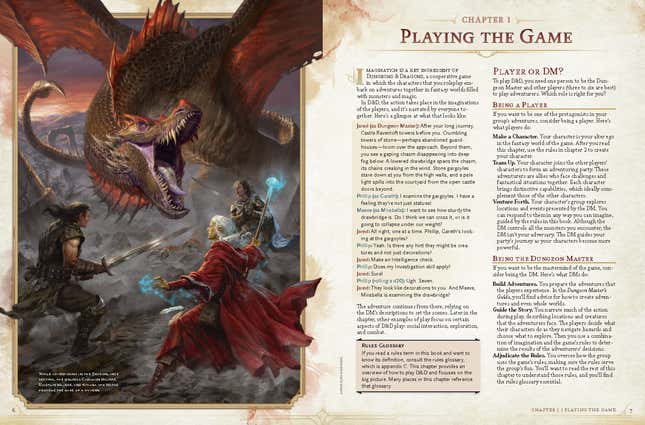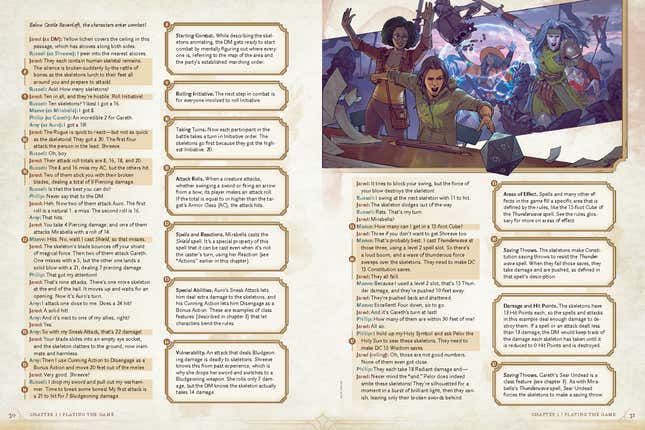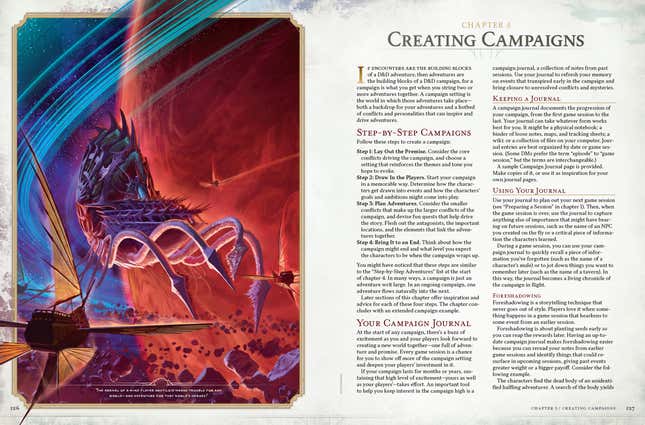Every year for the past few years, Dungeons & Dragons has gotten bigger than ever. Now, in 2024 with the twinned anniversaries of its latest, fifth edition turning 10, and the RPG series at large turning 50, the game is ready to shape the next decade of adventuring—and its new versions of the core rulebooks are nearly ready to point the way.
“Several years ago, we felt that one of the best ways for us to celebrate 50 years of D&D was to return to the core books themselves, really the foundation of the entire game, and lovingly go through every piece of these books, incorporate all of the lessons we’ve learned over the last decade, and really make the best versions of these books that we could make,” Jeremy Crawford, D&D’s principle Rules Designer, recently told press over zoom, detailing Wizards of the Coast’s latest trio of core rulebooks—not, as they have been in the past, the starting point for a brand new definitive edition of Dungeons & Dragons, but an evolution of the living game the TTRPG has become over the course of the last decade in its fifth iteration. “People are going to see not only many of the elements that they have loved, but also many new elements and also tons of the pieces of the game that people have been enjoying over the last decade are now improved.”
Much of what can be found across all three core rulebooks—two of which, the Player’s Handbook and Dungeon Master’s Guide, will release in September and November of 2024, respectively, with the third, the Monster Manual, arriving in February 2025—will be familiar to players of Dungeons & Dragons in the here and now, a consolidation of updates and errata that have come in 10 years of the game, but years and years of the “Unearthed Arcana” program, a playtest environment for updates, class tweaks, new subclasses and more that while, not “official,” has provided a player-driven proving grounds for material that would go on to become part of Fifth Edition’s official sourcebooks. The Player’s Handbook, for example, now contains 48 subclasses across D&D’s 12 primary classes—drawn across years of expansion to those classes and subclasses that players have helped test and develop across D&D’s fifth edition. If a subclass you play is included in the 2024 handbook? It is now the definitive version of that subclass, overriding prior published editions—in some cases, almost radically, with Crawford describing the around 30 of those 48 classes as feeling “basically new.” If it isn’t? Then you can still play that subclass as it currently operates in D&D, fitting into the other tweaks to the mechanical act of actually playing the game.
“I think people are going to definitely want to transition [to the new books], because it’s not only the amount of thrilling new material here, but also the returning material is clearer, better organized, also more tightly integrated with each other,” Crawford added. “And as you go through this book, you will see that we wove carefully all of the content in it, very tightly together, in a way that, is, is quite distinct.”

That construction is the thing that defines the three new core rulebooks more than any of the litany of specific rules changes. The Player’s Handbook opens with a first for the rulebook: not character creation, but an entire chapter dedicated to brushing up returning players and introducing new players entirely to the act of actually playing D&D. “We think the best place for brand new players to start is one of our starter sets, but despite the fact that starter sets are the the place to start, many people pick up the Player’s Handbook and try to give it a go,” Crawford noted, as well as acknowledging that there would indeed be a new Starter Set down the line tying into the updated rulebooks—but even its eventual existence won’t stop newcomers from picking up the Player’s Handbook as their first experience of D&D. “Accepting that reality, we decided to, for the first time in the game’s history, have the players handbook start with teaching you how to play the game. So chapter one, dives all into the the basic rules of the game… this chapter walks the reader step by step through all the basics of the game and will not only be pivotal for brand new players, but it will also be fundamental for all of our veteran players, because we manage to condense all of the game’s basic rules into this one chapter, and it’s not even that long.”
The opening chapter’s condensed introduction plays into another of the Player’s Handbook’s new structural features. The book culminates with a Rules Glossary—a list of rules referred to throughout each chapter, but intended to be a one-stop place for players and Dungeon Masters alike, instead of flipping through their books to find the information they need, to be able to innately go to the one place they actually need: the back of the book. “[It’s] not just the rules of the Players Handbook. It’s the rules of the entire game, and that glossary, we’re expecting, will turn into probably the most used part of the book,” Crawford explained. “One of the reasons we were able to keep the introduction to the rules pretty tight, is a lot of the nitty gritty details of the rules reside in the rules glossary—we can introduce a concept to you, and give you the information you do need to start playing, but if there’s some corner case stuff that you don’t need right away, we say, ‘now go take a look later on in the rules glossary for more.’”

These bookends of the Player’s Handbook are allowed, in part, due to an approach woven throughout the rest of its entirety: now more than ever, the core rule books are driven by example scenarios of play, small breakout conversations of a hypothetical Dungeon Master and their group as they experience a relevant element of D&D. These example scenarios aren’t just reflected in these breakout boxes—an element already leaned on throughout fifth edition—but will also include direct commentary from the rules writers, expanding on elements used in the play examples, and even artwork, filled with mishmashes of a fantastical scenario featuring adventurers and combat, contrasted their players sitting around a table actually playing that scenario out. “Part of the magic of Dungeons and Dragons is that when you’re playing it, you’re not only having an experience around the table, whether it’s a physical table or a virtual one with your friends in the real world,” Crawford added. “But you’re simultaneously also imagining this world where the characters’ action is taking place—so we wanted the art in this rules chapter to to really convey that, that dual nature of the game.”
These three ideas—a strong introduction for newcomers, a comprehensive glossary, and more examples of play—are similarly reflected in the companion release to the Player’s Handbook, the Dungeon Master’s Guide. “It was very important this time around, to me and to James [Wyatt, D&D game designer at Wizards of the Coast], and to the whole team, to make sure that this rebuilt Dungeon Master’s Guide is accessible to both new DMs and and seasoned DMs,” Chris Perkins, D&D senior story designer and self-described “Forever DM” said, as conversation turned to 2024’s other major core rulebook release. “[It was important] that it was easier to find the information you needed, that it becomes, in effect, the Dungeon Master’s companion, when they’re building their adventures and planning their game sessions, as well as when they’re running their game sessions.”

Like the Player’s Handbook, this follows a similar condensation of lessons and updates to D&D learned over a decade of fifth edition—and it also means a restructuring of the rulebook’s layout to effectively onboard, and re-onboard, current and new players. The opening chapters of the 2024 Dungeon Master’s Guide will re-introduce basic concepts—what a DM’s role at the table is, what they need to make a session run smoothly, how to react to player taste and how to run sessions with various group sizes. Those will, like the 2024 Player’s Handbook, be accompanied by in-depth examples of play. This “show, don’t tell” approach is especially important for the Dungeon Master’s Guide, Perkins explained, because the book is all about giving potential DMs ideas and frameworks to build their own material out of, instead of necessarily just the act of following along with a D&D campaign sourcebook. “We actually give you example adventures, several of them, and these are not in the style of our big published adventure books— they’re written in a way that we hope DMs will want to emulate for their home games,” Perkins noted. “It is a more streamlined version of adventure design, and the reason why we’re doing that is to be mindful of the of the DM’s time, to help them prepare adventures quickly—you don’t have to write an adventure out in the way we publish adventures. When you’re running your own adventures and designing your own adventures, there’s kind of a shorthand way that you can do it, and we show you how, and then we give you several examples.”
One of those examples is a first for the Dungeon Master’s Guide: an entire sample campaign setting, in the form of D&D’s first-ever officially published campaign setting, Greyhawk. “[Greyhawk] was sort of the template, for which all other campaign settings that have ever been created since, is modeled on,” Perkins said of the decision to include it in the Dungeon Master’s Guide. “When we were going back and looking at the original setting and why it was so inspiring to us, it was because, it’s rich with possibilities—it’s a sandbox full of toys that doesn’t spend too much time talking about itself, but spends a lot of time inspiring you to go off and kind of make what you will of it.” The 2024 Dungeon Master’s Guide uses Greyhawk as an example template to instruct DMs on how to develop a campaign in the setting, including all the necessary lore hooks—how to use the city of Greyhawk itself as a hub for a narrative, locations that can serve as gathering points or potential dungeon locations—all explained with examples and details that a DM could either use as-is, or as a template to create their own setting.

To help facilitate, that, the Dungeon Master’s Guide also includes a counterpart to the Player’s Handbook rules glossary—a lore glossary filled with details about major characters, places, substances, and general D&D terms to both introduce newcomers and remind veteran players. But the Dungeon Master’s Guide goes a step further in its approach to “show, don’t tell” with a wealth of extra ancillary support material to aid players and DMs alike in tracking the course of a campaign—sheets available to download through D&D Beyond that act as an official way to facilitate notes players take in the first place, from tracking recurring NPCs, to expectations from a group, or ways to consolidate notes about plots or other important information as a campaign develops.
The point of it all—across the Player’s Handbook, across the Dungeon Master’s Guide, across the still-a-ways-off Monster Manual, the book least discussed by Perkins and Crawford with press due to its 2025 release date—is not necessarily to fundamentally re-shape the way D&D, now more popular than ever before, is played. Instead, these core rulebooks consolidate a decade’s worth of that popularity explosion, all the rules and ideas and concepts that have come with increased attention—and the harder lessons learned in player feedback on the occasions Wizards of the Coast has gotten things wrong—and use that consolidated information to create a stepping stone into D&D’s future going forward. One that Crawford hopes will make for an easy, symbiotic transition from Fifth Edition into a familiar, but updated, version of the game… to the point that the designer couldn’t even settle on which of the three books will be easiest for players to transition their current adventures and characters into utilizing.

“When it comes to the Player’s Handbook, that in many ways, will be the easiest [to integrate]. Well, actually, the Monster Manual… both of them easy are to integrate into an existing campaign, because, you could just decide ‘we’re going to retool our characters in our existing campaign to use the versions of the features in the new Player’s Handbook.’ The monsters in the new Monster Manual can be dropped into your existing campaign, and they are designed so that even if you’re running in an official [Fifth Edition] adventure, ad that adventure calls for a particular stat block, as soon as you have the new Monster Manual, you can use its stat blocks going all the way back to the earliest days of our official adventures,” Crawford pondered. “Similarly, the magic items in the The new Dungeon Master’s Guide can be integrated into your ongoing campaign—really, all of it is, particularly on the DM side, super easy to integrate any of the material, because the players often won’t even know, ‘Oh, the DM is using a spell that is using the the brand new version of this thing.’ With the player characters, it might just be you decide, ‘hey, we’re going to have a session where we retool our characters to use the new options,’ and then we just keep the campaign going.”
“Just keep going” seems to be important for D&D’s new era as the core rulebooks’ “show, don’t tell” mantra. Time will tell, as Wizards of the Coast begins to roll out further information on mechanics and rules that have changed definitively in the coming weeks and months, just how easy it will be for more players than ever to “just keep going,” but Dungeons & Dragons is hoping at least, that continuity of what came before, rather than outright invalidation, will make that process easier than any of its prior evolutionary growing pains have been.
The updated Player’s Handbook, Dungeon Master’s Guide, and Monster Manual are now available to preorder through D&D Beyond.
Want more io9 news? Check out when to expect the latest Marvel and Star Wars releases, what’s next for the DC Universe on film and TV, and everything you need to know about House of the Dragon and Lord of the Rings: The Rings of Power.
Trending Products

Cooler Master MasterBox Q300L Micro-ATX Tower with Magnetic Design Dust Filter, Transparent Acrylic Side Panel…

ASUS TUF Gaming GT301 ZAKU II Edition ATX mid-Tower Compact case with Tempered Glass Side Panel, Honeycomb Front Panel…

ASUS TUF Gaming GT501 Mid-Tower Computer Case for up to EATX Motherboards with USB 3.0 Front Panel Cases GT501/GRY/WITH…

be quiet! Pure Base 500DX Black, Mid Tower ATX case, ARGB, 3 pre-installed Pure Wings 2, BGW37, tempered glass window

ASUS ROG Strix Helios GX601 White Edition RGB Mid-Tower Computer Case for ATX/EATX Motherboards with tempered glass…










